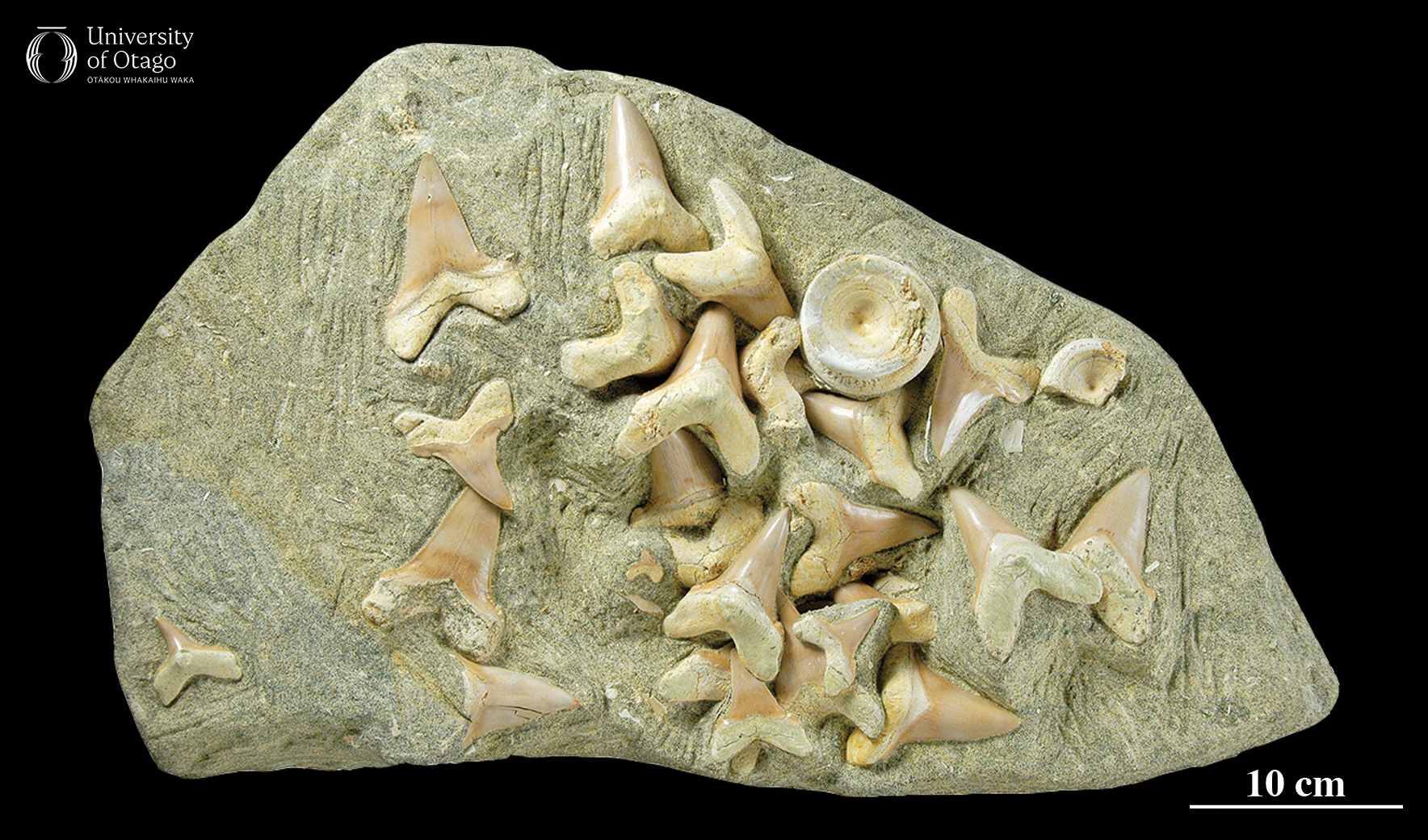1 Exceptional mega shark: distant ancestor of Jaws
Chondrichthyes, Elasmobranchii: Otodus angustidens
A set of more than 150 teeth from the extinct mackerel shark, Otodus (formerly Carcharodon) angustidens, is one of the most complete and best-preserved of its kind in the world.
|
Teeth and vertebrae from the mega shark Otodus (Carcharodon) angustidens (specimen OU 22261). More than 150 teeth were found as part of this fossil. Image credit: RE Fordyce. |
It is unusual to find a complete set of fossil teeth from one shark; rather, most fossil shark teeth are found one at a time. In living sharks, teeth are replaced continuously. Each tooth moves into position in the jaw where it works for a short time – perhaps a few weeks – before it drops out and is replaced. The shed teeth fall to the sea floor to become fossilised single teeth. A natural set of fossil teeth like this specimen marks the final resting place of a single animal. Here, the body of the shark decomposed, to leave only teeth, and a few vertebrae from the spine.
 |
Did you know there is a 3D printable model of this fossil for you to view online and download? Follow this link to learn more: 3D model—Exceptional mega shark: distant ancestor of Jaws. |
Otodus angustidens would have resembled the living great white shark, Carcharodon carcharias, but was larger than any living shark species. Proportions of teeth and vertebrae suggest that the extinct shark was more than 9 metres long and perhaps weighed around 8 tonnes. Living great white sharks reach about 6 metres long and weigh about 1.2 tonnes.
The specimen is from the upper Kokoamu Greensand or possibly the lower Otekaike Limestone and was discovered near Tokarahi, west of Oamaru. Of late Oligocene age, it was an apex predator in the shallow seas of North Otago, preying on penguins, fish, dolphins and baleen whales. The specimens are on display in the foyer showcase outside the Geology Museum. More teeth and vertebrae from this specimen can be viewed in the Southern Land, Southern People gallery in Tūhura Otago Museum in Ōtepoti Dunedin and a replica is displayed at the Vanished World Centre in Duntroon.
—Written by R Ewan Fordyce, with modifications by Daphne E Lee
| Specimen number: OU 22261 | Age: Approximately 26 million years old (late Oligocene, Duntroonian stage) |
| Locality: Tokarahi, North Otago | Rock Formation: Transitional zone between Kokoamu Greensand and Otekaike Limestone |
| Collected by: RE Fordyce, A Grebneff, B Black, H Ichishima, J Daniels, C Jenkins, G McMurtrie, G Curline, S Rust | |
| Citation: Gottfried MD, Fordyce RE. 2001. An associated specimen of Carcharodon angustidens (Chondrichthyes, Lamnidae) from the Late Oligocene of New Zealand, with comments on Carcharodon interrelationships. Journal of Vertebrate Paleontology 21:730–739. doi.org/10.1671/0272-4634(2001)021[0730:AASOCA]2.0.CO;2 | |
A type of large, fast-swimming shark belonging to the order Lamniformes. Living examples include great white shark (Carcharodon carcharias) and shortfin mako shark (Isurus oxyrinchus).
Evidence of life from a past geological age. Remains like bones, shells or wood, or an impression like a footprint, or some other evidence of life, from something that was alive more than 11,700 years ago.
The process by which organic structures like animal bodies or tree trunks are broken down into simpler organic matter.
Green-grey, calcareous, glauconitic, quartz sandstone.
Coarse-grained, sandy limestone.
33.9 to 23.03 million years ago.
An animal that hunts other animals for food and which holds a position in a food web where it has no natural predators.
Marine mammals within Cetacea that have large keratin plates (baleen) for filtering food from water. One of two major clades within Neoceti, with the other being Odontoceti. Living examples include blue whale (Balaenoptera musculus) and southern right whale (Eubalaena australis).
See: Tūhura Otago Museum, Southern Land, Southern People.
Part of the UNESCO Waitaki Whitestone Geopark. See: Vanished World Centre.


